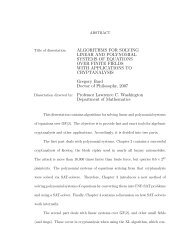SAGE: System for Algebra and Geometry Experimentation
SAGE: System for Algebra and Geometry Experimentation
SAGE: System for Algebra and Geometry Experimentation
Create successful ePaper yourself
Turn your PDF publications into a flip-book with our unique Google optimized e-Paper software.
ACM SIGSAM Bulletin, Vol 39, No. 2, June 2005Timely Communication<strong>SAGE</strong>: <strong>System</strong> <strong>for</strong> <strong>Algebra</strong> <strong>and</strong> <strong>Geometry</strong> <strong>Experimentation</strong> ∗William SteinUniversity of Cali<strong>for</strong>nia at San Diegowstein@ucsd.eduDavid JoynerMathematics Department, US Naval Academywdj@usna.edu<strong>SAGE</strong> is a framework <strong>for</strong> number theory, algebra, <strong>and</strong> geometry computation that is initiallybeing designed <strong>for</strong> computing with elliptic curves <strong>and</strong> modular <strong>for</strong>ms. The current implementationis primarily due to William Stein. It is open source <strong>and</strong> freely available under the terms of theGNU General Public License (GPL).<strong>SAGE</strong> is a Python library with a customized interpreter. It is written in Python, C++, <strong>and</strong> C(via Pyrex). Python is an open source object-oriented interpreted language, with a large numberof libraries, e.g., <strong>for</strong> numerical analysis, which are available to users of <strong>SAGE</strong>. Python can also beaccessed in library mode from C/C++ programs.<strong>SAGE</strong> will provide a unified interface to several important open source libraries, including JohnCremona’s MWRANK library <strong>for</strong> computing with elliptic curves, the PARI library <strong>for</strong> numbertheory, <strong>and</strong> Shoup’s number theory library NTL. There is also a tentative plan to incorporate aninterface to SINGULAR (<strong>for</strong> commutative algebra) <strong>and</strong> GAP (<strong>for</strong> group theory).The design of <strong>SAGE</strong> is heavily influenced by the carefully thought out <strong>and</strong> mature class structureof the closed source computer algebra program MAGMA. When possible, classes have similar names,constructors, <strong>and</strong> print representations as in MAGMA, <strong>and</strong> similar functions are available. However,<strong>SAGE</strong> is not meant to be an exact clone of MAGMA.The main longterm goals <strong>for</strong> <strong>SAGE</strong>:• Efficient: Be very fast—comparable to or faster than anything else available. This is verydifficult, since many systems are closed source, algorithms are sometimes not published, <strong>and</strong>finding fast algorithms is often extremely difficult (years of work, Ph.D. theses, luck, etc.).• Free <strong>and</strong> open source: The source code must be freely available <strong>and</strong> readable, so users canunderst<strong>and</strong> what the system is really doing <strong>and</strong> more easily extend it. Just as mathematiciansgain a deeper underst<strong>and</strong>ing of a theorem by carefully reading or at least skimming the proof,people who do computations should be able to underst<strong>and</strong> how the calculations work byreading documented source code.• Easy to compile: <strong>SAGE</strong> should be relatively easy to compile from source <strong>for</strong> Linux <strong>and</strong> OS Xusers. This provides more flexibility in modifying the system.∗ This material is based upon work supported by the NSF under Grant No.0400386.61
<strong>SAGE</strong>: <strong>System</strong> <strong>for</strong> <strong>Algebra</strong> <strong>and</strong> <strong>Geometry</strong> <strong>Experimentation</strong>Timely Communication• Comprehensive: Implement enough algorithms to be really useful.• Tools: Provide robust interfaces to some of the functionality of PARI, GAP, GMP, SINGU-LAR, MWRANK, <strong>and</strong> NTL. These are all are GPL’d <strong>and</strong> <strong>SAGE</strong> provides (or will provide) aunified interface <strong>for</strong> using them.• Cross-plat<strong>for</strong>m: <strong>SAGE</strong> runs under Linux, OS X, Windows (cygwin). (Solaris is not supportedyet.)• Well documented: Reference manual, API reference with examples <strong>for</strong> every function, <strong>and</strong> anextensive tutorial.• Extensible: Be able to define new data types or derive from builtin types, <strong>and</strong> make codewritten in your favorite language (including C/C++) part of the system.• User friendly: The hope is to eventually attain a high level of user support. (The GAP Forumemail list is an ideal example of the support it is hoped that <strong>SAGE</strong> can attain.)As mentioned above, <strong>SAGE</strong> runs on many plat<strong>for</strong>ms <strong>and</strong> operating systems (Windows, MacOS X, FreeBSD, <strong>and</strong> Linux—both 32-bit <strong>and</strong> 64-bit). Moreover, it can be downloaded both as a“binary” <strong>and</strong> as source code that you compile yourself. You can download <strong>SAGE</strong>, an installationguide <strong>and</strong> a tutorial, from its webpage http://sage.source<strong>for</strong>ge.net. The windows version hasan easy installer <strong>and</strong> the linux compilation is very straight<strong>for</strong>ward if you have the tools (make,gcc, etc.). Although <strong>SAGE</strong> uses Python <strong>and</strong> PARI <strong>and</strong> other packages, keep in mind that it isnot necessary to have this software preinstalled on your computer. The installation of <strong>SAGE</strong> isreally designed to be relatively painless, but if you have any problems, please ask. Moreover, ifyou have installed <strong>SAGE</strong> once, upgrading to the newest version is especially easy with the “makeweb-update” comm<strong>and</strong> (this is described on the website given above <strong>and</strong> assumes you have wgetinstalled <strong>and</strong> an internet connection).In this brief space, we only give one example of <strong>SAGE</strong>. Here is an example of computing withan elliptic curve. The EllipticCurve comm<strong>and</strong> has several <strong>for</strong>ms:• EllipticCurve([a 1 ,a 2 ,a 3 ,a 4 ,a 6 ]): Elliptic curve y 2 + a 1 xy + a 3 y = x 3 + a 2 x 2 + a 4 x + a 6 ,where the a i ’s are coerced into the parent of the first element. If all are integers, they arecoerced into the rational numbers.• EllipticCurve([a 4 ,a 6 ]): Same as above, but a 1 = a 2 = a 3 = 0.• EllipticCurve(label): Returns the elliptic curve over Q from the Cremona database withthe given label. The label is a string, such as "11A" or "37B2".• EllipticCurve(R, [a 1 ,a 2 ,a 3 ,a 4 ,a 6 ]): Create the elliptic curve over a ring R with givena i ’s as above.Some examples using this comm<strong>and</strong>:62
Stein, Joynersage: EllipticCurve([0,0,1,-1,0])Elliptic Curve defined by y^2 + y = x^3 - x over Rational Fieldsage: EllipticCurve([GF(5)(0),0,1,-1,0])Elliptic Curve defined by y^2 + y = x^3 - x over Finite field of size 5sage: EllipticCurve(GF(5), [0, 0,1,-1,0])Elliptic Curve defined by y^2 + y = x^3 - x over Finite field of size 5Here GF(5)(0) denotes the zero element of the field with 5 elements. As indicated above, the lasttwo comm<strong>and</strong>s are essentially equivalent.The elliptic curves over the complex numbers (denoted CC in <strong>SAGE</strong>) are parameterized by thej-invariant. <strong>SAGE</strong> can compute these j-invariants:sage: E = EllipticCurve([CC(0),0,1,-1,0])sage: EElliptic Curve defined by y^2 + y = x^3 - x over Complex Fieldsage: E.j_invariant()2988.97297297297297297Obviously x = y = 0 is a point on the elliptic curve E : y 2 + y = x 3 − x. To create this point in<strong>SAGE</strong> type E([0,0]). <strong>SAGE</strong> can add points on such an elliptic curve (recall elliptic curves supportan additive group structure where the “point at infinity” is the zero element <strong>and</strong> three co-linearpoints on the curve add to zero):sage: E = EllipticCurve([0,0,1,-1,0])sage: Ey^2 + y = x^3 - xsage: P = E([0,0])sage: 10*P(161/16, -2065/64)sage: 20*P(683916417/264517696, -18784454671297/4302115807744)Finally, <strong>SAGE</strong> can use the Cremona database <strong>for</strong> elliptic curves 1 .sage: <strong>for</strong> E in curves(prime_range(100)):...: print "%s\t%s"%(E.cremona_label(), E.rank())...:11A1 011A2 011A3 017A1 01 All these comm<strong>and</strong>s have been tested using the 6-2-2005 version of <strong>SAGE</strong> with the Cremona databasedb-elliptic-curves-0.3. However, only the comm<strong>and</strong>s in the “<strong>for</strong> loop” require the database, which must beinstalled separately (as explained on the <strong>SAGE</strong> website). Note also that the curves comm<strong>and</strong> name may change toelliptic curves in a future version of <strong>SAGE</strong>.63
<strong>SAGE</strong>: <strong>System</strong> <strong>for</strong> <strong>Algebra</strong> <strong>and</strong> <strong>Geometry</strong> <strong>Experimentation</strong>Timely Communication17A2 017A3 017A4 019A1 019A2 019A3 037A1 137B1 037B2 037B3 043A1 153A1 161A1 167A1 073A1 073A2 079A1 183A1 189A1 189B1 089B2 0This is just a quick illustration of the many elliptic curve computations that <strong>SAGE</strong> can alreadydo. For further examples (using linear algebra, modular <strong>for</strong>ms, <strong>and</strong> so on), please see the <strong>SAGE</strong>tutorial.<strong>SAGE</strong> is in an early stage of development, but is actively growing, <strong>and</strong> is already usable. Thereis a <strong>SAGE</strong> discussion board, bug-tracker, <strong>and</strong> wish list. If you are interested in using such a system,or in contributing in any way to its development, please visit http://sage.source<strong>for</strong>ge.net oremail William Stein at wstein@ucsd.edu.64
















